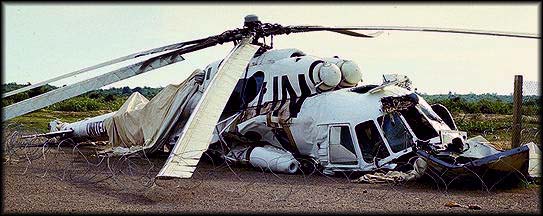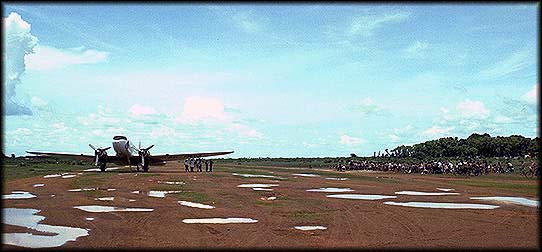The Remaining Right Side of the Buddha
Part 12: Flying with Goats - The Return to Phnom Penh
Sunday - May 30, 1993
Sunday morning, Ken, Paul and I said goodbye to the others and headed to the airport. We had come to Siem Reap on a one-way
ticket, leaving open the possibility of hitching a free ride back on an UNTAC aircraft. When we first arrived in Siem Reap, Ken had
asked a couple of Dutch pilots about the prospect of getting on a flight. Their reply: "If you're brave enough to come up here why
don't you ride a bicycle back."
In any case, we'd heard that Friday had been the last day for press to fly with UNTAC. So we weren't optimistic and figured we'd have
to pay the US$47 and go with Kampuchea Airlines (at least there was a flight that day; the previous two days, the flights had been
canceled). We decided to arrive at the airport early and ask around just in case.
We found some Aussie UNTAC guys and Paul chatted them up. They said that an UNTAC plane was headed for Phnom Penh within
the hour. The plane belonged to Morris Catering, an Australian company that had the US$63 million contract to handle food
preparation and distribution for the 20,000 UNTAC troops.
The Aussies sent us down to the far end of the airfield to inquire about the cargo plane. We walked across a field of tall grass and
found Morris' small office. We were told our chances were good for getting on the flight, but that we would have to wait to ask the
pilots.
While we waited we checked out the remains of a squashed UNTAC helicopter that was sitting at the end of the runway. Its rear rotor
had failed causing the body of the craft to spin with its top rotor and plummet to the ground. We took turns climbing into what remained of the cockpit and took some photos. I pocketed the aircraft's last flight log as a souvenir.

The pilots eventually arrived and turned out to be real friendly guys. Dennis, the pilot from England, and John, the co-pilot from New
Zealand, said sure, no problem, we could ride. There was one catch however; we would be responsible for keeping watch over the
eleven live goats that were to be our cargo. The goats were destined for Kompong Chnnang near the banks of the Tonlé Sap where
the Tunisian UNTAC regiment was celebrating a Muslim holy day. The goats were required for ritual sacrifice. We would thus have
a stop on the way to Phnom Penh.
A truck arrived with the goats and they were hoisted, one by one, kicking and screaming, onto the plane through the large cargo door
in the side. One escaped and darted off into the field; three Cambodian men in hot pursuit. That was to be that goat's final flirtation
with freedom. It was caught and unceremoniously carried back to the plane where it joined the others.
Before taking off we were joined by one more passenger. Loretta, an American based in Beijing, was the Asia correspondent for
the Philadelphia Inquirer. Behind the pilots' seats there was a small space with a folding chair for a passenger. Additional
passengers would have to ride in the cargo-hold. Loretta got the sole passenger seat and Ken, Paul and I climbed in with the goats.
The plane was a twin propeller DC-3 (Dakota) built in 1945. Flying in it was far different from any flying I've done before or since.
We stood in back hanging on to whatever we could grab. Ascents, descents and turns were much more severe than on commercial
flights - somewhat more akin to an amusement park ride. We each had a turn sitting in the co-pilot's seat - looking over the Tonlé
Sap and chatting with Dennis on the intercom headset. Paul had just gotten his commercial flyer's license and was thrilled to get
the opportunity to fly the thing.
I was sitting up front with Dennis when he radioed the Kompong Chnnang airfield to announce our approach. I listened on the
headset as he repeatedly got no answer. As it turned out, there was no tower at Kompong Chnnang but having never been there
before, Dennis wasn't aware of this fact.
The airfield was just a dirt strip in a field with some portable UNTAC buildings at one end. As we approached we saw kids playing
on the airstrip and village people crossing it on bicycles. We flew in low and then pulled up and the village people got the message
that we wanted to land. They cleared out by the time we came around the second time.
The portion of airstrip that we touched down on was reasonably smooth but as we taxied to a stop we encountered large, water-filled potholes as bad as those that dotted the Cambodian roads. As the plane bounced, those of us in the back held on tightly.

An assortment of UNTAC officers and Civpol from various countries came to greet us as we descended down the ladder from the plane. Heavily armed soldiers kept the growing crowd of village people off of the strip. Some Tunisians arrived and informed us that the 36 goats they'd ordered had already arrived earlier that morning. They didn't need or want the eleven that we were carrying.
At the trailer offices we attempted to sort out the mess. I begged out of the discussions saying it was not my affair and took up
conversation with a German soldier. The German showed me a Khmer Rouge uniform he'd gotten from his friends... the Khmer
Rouge. He said the Khmer Rouge could get him anything he wanted. Maybe he didn't know about the Bulgarians who had invited
some Khmer Rouge soldiers to dine with them one evening. After the dinner, the Khmer Rouge excused themselves, then returned
with their guns and shot the place up killing a few of their hosts and injuring others.
Eventually the Tunisians agreed to take the goats and we were off again; over Udong and into Pochentong airport. A driver picked
us up and took us to the Morris offices for a beer - there was a bar and rec room on the second floor above the offices. As we
approached the building, it dawned on me that this was the company that Theary had worked for before being hired at the UN
Human Rights office.
John (the co-pilot) invited us to a party that night that Morris was throwing for the international press and we returned to the good old
Happy Guest House. Tee, the one-legged proprietor, greeted us and we told him about our adventures.
The party that night was at the Royal Hotel - one of a handful of French colonial gems of faded glory. Photocopied invitations had
been circulating during the afternoon at the Capitol. The invitations claimed that there'd be barbecued crocodile, kangaroo and
witchety-grubb. The Aussies amongst us were as surprised by that menu as the rest of us and there was some speculation that this
was a put-on - most had never eaten such foods.
The party was to be invitation only and the photocopies were only valid with an official stamp. There were numerous attempts to
produce fakes but those who did needn't have bothered as the invitations weren't checked.
We entered through the Royal's lobby and continued on out to the poolside courtyard where festivities were in full swing. Large
barbecue pits were being used and sure enough the main courses were crocodile, kangaroo and witchety-grubb. There was also
plenty of Australian beer.
The guest of honor was a live ten-foot long crocodile that was chained to a tree. It was heavily sedated so that drunk guests could
pose for photos while squatting over it or dress it up in caps and sunglasses. Still, it would periodically start thrashing about.
As the guests - who were primarily reporters or UNTAC administration workers - consumed more beer, more and more of them were
tossed fully-clothed into the swimming pool. At some late hour, Paul, Ken and I hailed a cyclo driver for the ride back to the guest
house. The driver got in the seat with Ken and I while Paul pedaled us down a deserted Achar Mean. We sang loudly and off-key
much to the amusement of the relaxing driver. |